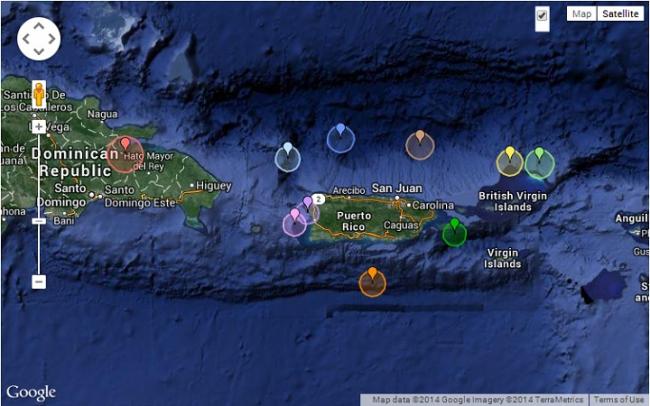In the past two months Haiti and Chile in the western Hemisphere were hit by devastating earthquakes. In Haiti this created severe loss of life and destruction and in Chile although less destruction and loss of life there were threats to countries several thousand miles away because of the ensuing tsunami. After seeing the catastrophic results of the earthquake and the human suffering in Haiti, I would not like to see a similar event that would encompass most of the Caribbean countries.
Guyana and most of the Caribbean countries lies in a region which, although not known for devastating earthquakes are vulnerable to the tsunami that could ensue from an earthquake in the North Atlantic. The North Atlantic region and specifically the Azores is the home of the converging fault lines of the African (AFR), European (EUR) and North American (NAM) plates. This region has experienced at least two significant earthquakes in the past 300 years that have caused substantial damage to the land in the region. One was near Lisbon, Portugal in 1775 and the other offshore Newfoundland in 1929.
A look at some of the facts and data surrounding these events present us with reasons for concern.
The Lisbon earthquake occurred at 9.30 a.m. on November 01, 1775 with an estimated magnitude of 8.5-9.0. It directly impacted not only Portugal but the effect on all of Europe was profound and lasting. This quake left over 100,000 people dead and created a tsunami waves 5–15 meters high, that devastated the coasts of Southwest Iberia and Northwest Morocco and were even reported as far north as Cornwall, England about 1000 miles away. The large tsunami-wave generated by the earthquake landed in the northern most Caribbean islands later that afternoon also causing damage in the eastern Lesser Antilles, as far north as Newfoundland, Canada and as far south as Brazil. According to one study the Eastern Caribbean countries experienced wave amplitudes of between 1 to 2 meters.
In 1929, an earthquake struck the Grand Banks off Newfoundland with a magnitude of 7.2 at a depth of 20km.It triggered a submarine landslide and tsunami that struck Newfoundland’s sparsely settled coast, where it killed 27 people with waves as high as 20 feet. The generated tsunami although small, took about 4 hours to get to the northern most Caribbean islands and about 5.5 hours to get to the coast of South America.
The experts stated that an event like this, involving a submarine landslide, may be the most likely scenario for the Atlantic coast. Scars of past large submarine landslides abound on the continental slope off the U.S. Atlantic coast. They further state that these events are a limited hazard to the US and Canada Atlantic coast as large earthquakes rarely occur in the vicinity of the U.S. and Canada Atlantic coast–perhaps once a century, on average (Boston area, 1755; Charleston, 1866; Newfoundland, 1929).
On October 11, 1918, the island of Puerto Rico was struck by a magnitude 7.5 earthquake, centered approximately 15 kilometers off the island’s northwestern coast, in the Mona Passage. In addition to causing widespread destruction across Puerto Rico, the quake generated a medium sized tsunami that produced “run-up” as high as 18 feet along the western coast of the island and killed 40 people, in addition to the 76 people killed by the earthquake.
In 1946 off the coast of the Dominican Republic more than 1,600 people were reportedly killed by a tsunami triggered by an earthquake with a magnitude 8.1.
Another tsunami scenario for the Atlantic coast that has been widely publicized is a landslide involving collapse of part of the Cumbre Vieja volcano in the Canary Islands (off the coast of Morocco) into the sea. According to some reputable sources during a future unascertained eruption, the western half of the volcano could collapse into the ocean and cause mega tsunamis with local wave amplitudes in excess of 600 meters. This wave could travel across the Atlantic at about 1000km/hr (521mph) inundating the African coast in about 1 hour, the southern coast of England in about 3.5 hours, and the eastern seaboard of North America in about 6 hours, by which time the initial wave would have subsided into a succession of smaller ones each about 30 meters (98 ft) to 60 meters (197 ft) high. These may surge to several hundred meters in height and several miles apart but retain their original speed. Experts suggest that tsunami could inundate up to 25 kilometers (16 mi) inland. This would greatly damage or destroy cities along the entire North American eastern seaboard. It is estimated that the physical damage would take tens if not hundreds years to repair and restore. The economies of the countries affected would likewise take several years to return to the pre-inundation levels.
With the probable devastation of North American eastern seaboard cities by a mega tsunami the effects would certainly be felt by most Caribbean countries with similar consequences.
Below is an excerpt of a statement by Charles G. Groat Director, U.S. Geological Survey, U.S. Department of the Interior before the Committee on Science U.S. House of Representatives January 26, 2005. Click on the following link to see the full article.
U.S. Geological Survey
Tsunami threats in the Atlantic
With respect to tsunami hazard risk to the U.S. East coast, it should be noted that subduction zones are scarce in the Atlantic Ocean. But the Atlantic Ocean is not immune to tsunami. A tsunami following the great 1755 Lisbon earthquake, generated by collision of the African and Eurasian tectonic plates, devastated coasts of Portugal and Morocco, reached the British Isles, and crested as much as 20 feet high in the Caribbean.
Tsunami threats in the Caribbean
The Caribbean is subject to a broad range of geologic processes that have the potential to generate tsunami. Indeed, the Caribbean tectonic plate has almost all of the tsunami-generating sources within a small geographical area. Subduction zone earthquakes of the type that generated the Indian Ocean tsunami are found along the Lesser Antilles and the Hispaniola and Puerto Rico trenches. Other moderately large earthquakes due to more local tectonic activity take place probably once a century, such as in Mona Passage (1918 tsunami) and in the Virgin Islands basin (1867 tsunami). Moderate earthquakes occur that may trigger undersea landslides and thus generate tsunami. An active underwater volcano (Kick’em Jenny near Grenada) where sea floor maps show previous episodes of flank collapse also poses a tsunami hazard. Above-water volcanic activity occurs, wherein the Lesser Antilles periodically generate landslides that enter the sea to cause tsunami. And finally, the possibility exists of tele-tsunami from the African-Eurasian plate boundary, such as the great Lisbon earthquake of 1755 described above.
Tsunami History
In 1867, an 18-foot high tsunami wave entered St. Thomas’ Charlotte Amalie at the same time that a 27-foot wave entered St. Croix’s Christiansted Harbor. Were that to occur again today, the 10-fold increase in population density, the cruise ships, petroleum carriers, harbor infrastructure, hotels and beach goers, nearby power plants, petrochemical complexes, marinas, condominiums, and schools, would all be at risk.
According to other experts, although fewer tsunamis have occurred in the Caribbean than in the Pacific, more fatalities due to tsunamis have occurred in the more densely populated Caribbean than in the U.S. West Coast and Alaska combined. Also it is important to note that if a Lisbon 1755 type event occurred now, its consequences would be very significant in view of increased population and coastal infrastructure after 1755.
With all of the above data it should be noted that we are in the 100 year time frame of experiencing another major earthquake like the one off of Newfoundland and over 235 years have passed since the one near Lisbon. With this information and all of the recent earthquake occurrences in the hemisphere my questions to the Government of Guyana and the heads of Caribbean nations are:
• Do we have an emergency preparedness plan regarding earthquake/tsunamis?
• Are we in constant (24 x 7) communication with the U.S. National Oceanic and Atmospheric Administration to get immediate notification in the event of a tsunami or earthquake?
• Do we have an evacuation plan and has it been tested?
• Do the citizens know of the emergency plan, the warnings and actions to take?
• Do we have a plan for securing the governments and governing from a remote location?
• Do we secure all or historical and critical data in areas that are sheltered from these events?
• Do we have an emergency communication plan and has it been tested?
• Do we have a plan to ensure that our populations have access to basic necessities such as food, water, shelter, medical assistance in the event of a catastrophe of this nature?
• Do we have any reciprocal agreements amongst our geographical neighbors for a joint task force to provide technical, political, and management oversight of all of the above?
These questions are proposed to stimulate conversations and subsequent actions in a pre-mortem versus post-mortem setting. An added benefit to immediate preparations is the enhanced business opportunities and hence economic growth by new industries. This will create additional jobs and stimulate sagging economies in these tough economic times.
Ian G. Hall
References:
• http://archives.cnn.com/2001/TECH/science/08/29/tidal.wave/
• http://home.iitk.ac.in/~vinaykg/Iset_42_tn3.pdf
• http://soundwaves.usgs.gov/2005/10/meetings.html
• http://nisee.berkeley.edu/lisbon/





